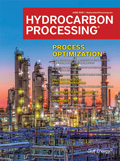
June 2018
Special Focus: Process Optimization
In this study, a methodology was implemented to predict crude distillation tower flooding events based on key process variables, including product yields, column pumparound (PA) flowrates, column temperatures and overhead reflux flowrate.
A rigorous and accurate performance evaluation of existing equipment is a key factor for the success of a plant revamp study.
Within the hydrocarbon processing industry (HPI), particularly the petrochemical sector, there remains an irritating series of reactions associated with acid gas removal (AGR) using dilute caustic soda—namely, aldol condensation reactions and their respective products.
Installation and operation of suitable contaminant removal systems, such as filtration, coalescing and adsorption equipment, have become key components in amine units.
The increased use of opportunity crude oils in refinery processing, the growing demand for light fuel, and the efficient conversion of petroleum resources to refined fuels and basic chemical raw materials have become the basis of green and low-carbon refining technology developments.
Process Control and Instrumentation
Following good experience with a generalized cut-point calculation (GCC) inferential package, which models main fractionators with side streams, French energy major Total decided to experiment with a generalized distillation shortcut (GDS) inferential package, which models simpler, two-product distillation columns.
Maintenance and Reliability
A facility’s ability to operate safely is the determining factor in its success or failure.
Project Management
For large projects, construction represents the biggest cost component and the greatest risk.
Columns
During the American Institute of Chemical Engineers’ (AIChE’s) Spring Meeting, held in Orlando, Florida in April, I was honored to sit on a panel discussion with Paul Durand from ExxonMobil and Sanjeev Kapur from Apex PetroConsultants.
We often make the mistake of letting our equipment selection decisions be governed by old data, anecdotes and traditions.
Open process automation was once again a hot topic at the 2018 ARC Industry Forum in Orlando, Florida earlier this year.
Germany produces very little domestic oil and natural gas, and relies on imports to meet 95% of its oil consumption.
East Africa developed coordinated fuel standards as early as January 2015.
The gas processing and pipeline industries use many integral gas engine reciprocating compressors with crankshafts more than 20 ft long.
It is no surprise that electric vehicles (EVs) are getting a lot more attention, now that carmakers have announced plans to increase production of them.
Fuel is a necessary requirement of global economic development.
Equipment failures are the thorn in every industrial plant’s side.
Trends and Resources
Petrochemicals and gas processing/LNG sectors see largest increase in new projects.
Process manufacturing, which typically includes refining, petrochemicals and commodities chemicals, has traditionally focused on stability, controllability and optimization.
ACHEMA is the world forum for chemical engineering, process engineering and biotechnology.
Reduced refinery output caused by planned and unplanned refinery outages, and record-breaking gasoline export levels and strong diesel inventory drawdowns, drove US margins to a record 3-yr high in April.
According to Hydrocarbon Processing’s Construction Boxscore Database, nearly 450 downstream projects are under construction around the world.
The BASF board of executive directors has made several personnel changes.

- MOL Group introduces eco-friendly Bag-in-Box packaging for lubricants 12/5
- Honeywell to supply integrated automation systems for flagship UK carbon capture projects 12/4
- Aduro Clean Technologies collaborates with ECOCE to advance plastics recycling in Mexico 12/4
- FincoEnergies launches GoodFuels B15: A reliable and compliant drop-in biofuel for inland shipping 12/4
- DevvStream, Southern Energy Renewables target low-cost, carbon-negative SAF and green methanol 12/4
- AFPM: Revised fuel economy standards would put CAFE back on solid legal footing 12/4




